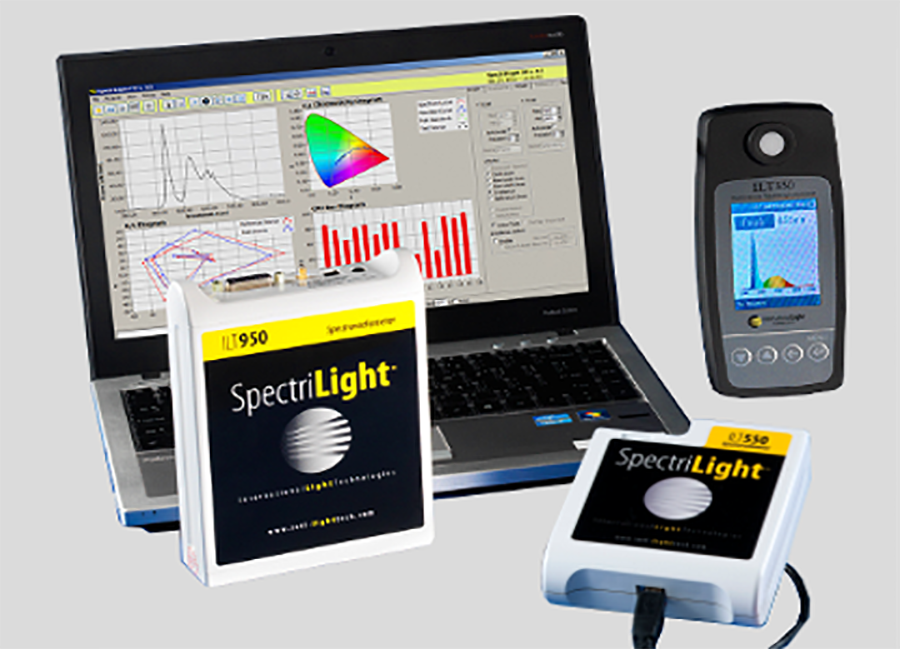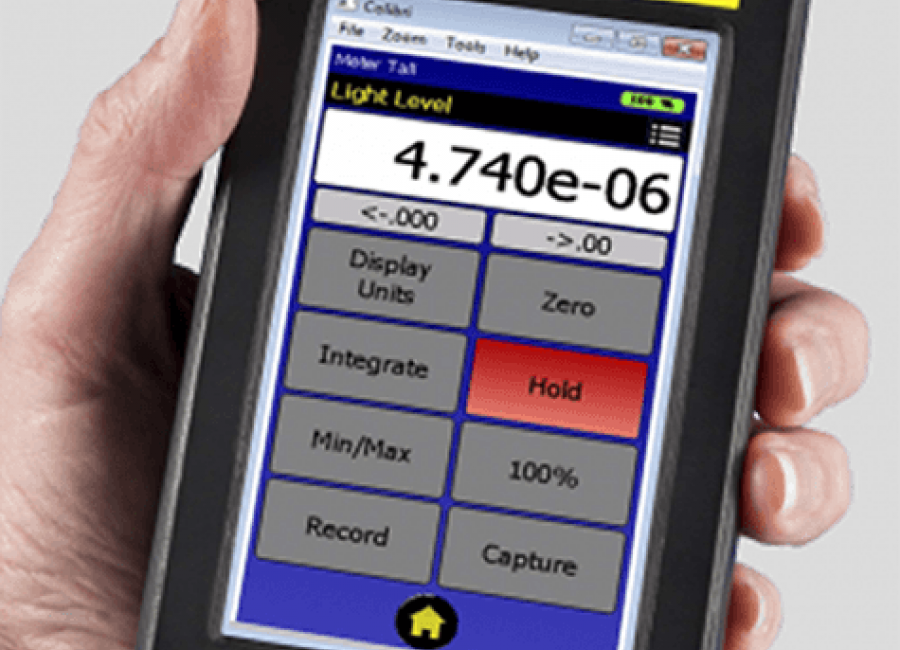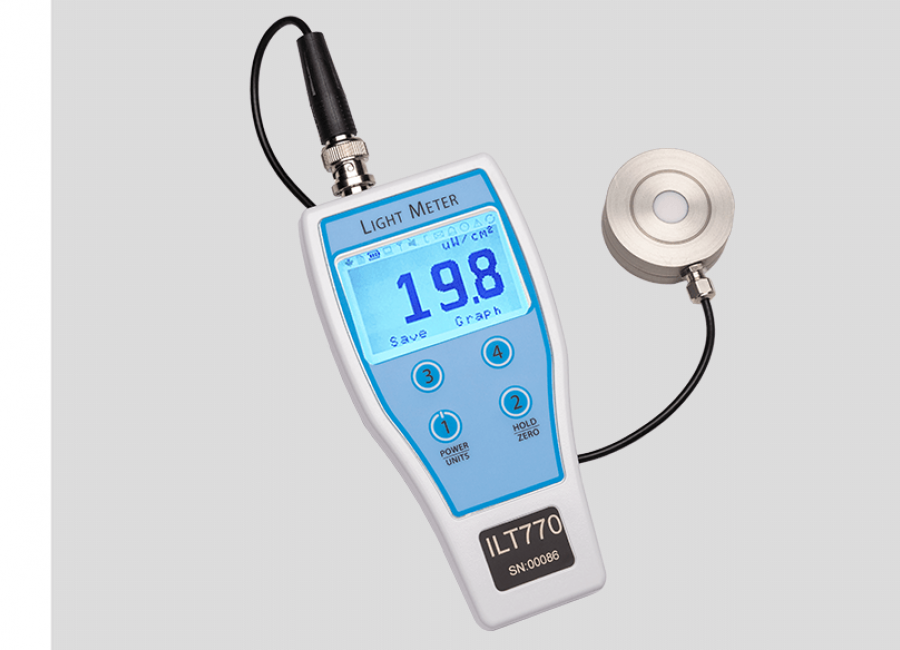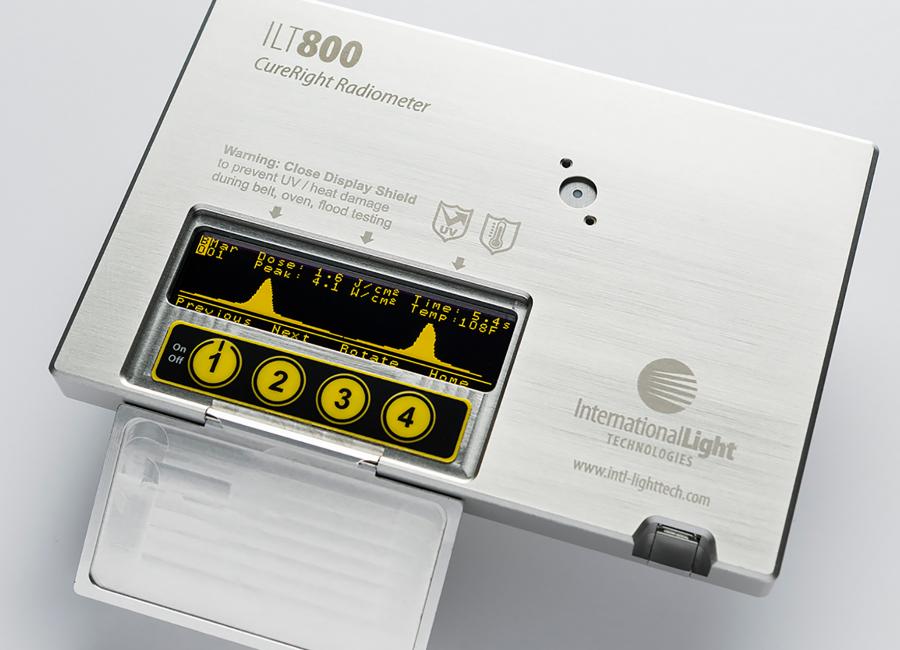
A Spectrometer measures light similar to how a camera takes a picture. The spectrometer takes a quick snap shot of the light and provides an image (or graph) of the light output. It does this by letting in light in for a short period of time, breaking down the incoming signal and spreading it across a sensor array which separates out each wavelength and then scales it based on the sensors sensitivity and the incoming signals amplitude.
Radiometers are similar in that they measure the lights output/amplitude, but differ in that they cannot tell you which wavelength(s) were emitted or their individual amplitude. A Radiometer typically measures the incoming current or voltage from the sensor which is proportional to the light level that reaches the sensor. The meter then applies a correction/calibration factor to the incoming signal to provide a calibrated light level measurement. The meter provides a single reading for all wavelengths of light reaching the sensor in one combined result.
The Spectrometer is the base unit of a Spectroradiometer. Spectroradiometers include input optics and calibrations that allow the spectrometer to take calibrated readings of power, intensity, and irradiance/radiance in optical units or lux/nm, lumens/nm, watts/nm, W/cm2/sr/nm etc. Though to be clear, many people interchange the terms calibrated spectrometer, spectrometer and spectroradiometer.
Spectrometers have internal sensors that can instantaneously measure the light and divide the incoming signal across a detector array which measures the signal in small bands or individual wavelengths based on the resolution of the system. (ie. 1 nm, 5 nm or 10 nm resolution). This is done through the use of CCD (charge coupled device) arrays, or CMOS (complementary metal-oxide semiconductor) image sensors.
Calibration is then applied to each wavelength to convert the signal of each pixel in counts to a calibrated reading of both amplitude and wavelength that is typically plotted in a graph on the internal display or on a PC. These calibrated wavelength and light level readings are then converted by numerous algorithms to calculate color temperature, duv, and CRI.

Spectrometers are most commonly sold to measure UV to VIS or NIR in a single scan. There are systems that are capable of measuring UVC and well as IR though typically the accuracy of these outer wavelengths is reduced especially for a broad band system.
Spectrometers can provide a highly accurate calibrated wavelength and light level reading provided the signal is strong enough across the full spectrum that is to be measured. Spectrometers do have issues with stray light and noise when the signal is weak in general or when the VIS/ NIR output is significantly stronger than the UV/IR.
A Radiometer or light meter typically consist of a meter body that measures current of voltage from an internal or external detector. The detector (sensor or photo-diode) is designed to measure a specific band of light as shown in the sensitivity curves below. (ie SiC (silicon carbide) 215-355, SI (silicon) 200-1100nm, InGaAs 850-1700 nm...)

Filters are then added to the sensor to pass the light that is to be measured and block the unwanted wavelengths from the measurements. The sensor filter combination creates the desired sensitivity curve, often called a bell shaped curved. Below are three different filters shown on the same silicon photo-diode to create 3 different sensitivity curves for UVA/VIS, UVA, and VIS.
There are also filters that are designed to offer more uniform sensitivity over a specific band which is especially useful for measuring LED’s, lasers and other narrow band sources.
Sensors are typically calibrated at the peak intensity and measure all of the light under the curve to provide one combined reading in units such as lux, W/cm2, Lumens, Watts, Candela etc.

Radiometers offer a more simple operation, and are less prone to noise and stray light when properly filtered. Since radiometers rely on the filter to create a match to the light source, variation in filters from different light meter manufactures add some difficulty when comparing results of light meters from different suppliers. Also the bell shaped curve of the filter can increase the total error for light sources that have numerous peaks or a peak that is not at the center wavelength of the filter. Some of these errors can be corrected with custom wavelength calibration and algorithms, while others are too difficult to correct with a single filter design. Many radiometers can be used with numerous sensors to cover many different bands of light such as UVA, 250-400, VIS etc.
ILT offers a variety of advanced handheld and research radiometers that can be combined with hundreds of sensors, filters and optics as well as low cost single application light meters. Our spectrometer line includes a hand held portable device, mini, lab grade and IR spectroradiometers with a full line of accessories and extensive software package. All ILT light measurement systems include NIST traceable and ISO/IEC 17025:2017 accredited calibrations.
Shop Our Spectrometers & Radiometers
- ILT960-UV Spectroradiometer: The ILT960-UV is a compact, portable mini spectrometer used to measure both the light's amplitude and wavelength, and provide calibrated spectral irradiance, or power measurements.
- ILT2400 Hand-Held Light Meter / Optometer: The ILT2400 is the most advanced hand held light meter and optoILT2400 hand held light meter/optometer on the market today. ILT’s Accuspan software automatically sets the averaging while rapidly measuring over 8 decades of light intensities.
- ILT770-UV UVC Light Meter for UV LED and Narrow-Band Sources: The ILT770-UV light intensity meter and measurement system as everything you need to start validating the light output of your UVC LED’s and other narrow-band UVC light sources.
- ILT800 CureRight Radiometer: The One Meter That Does It All! The ILT800 CureRight is a feature-rich profiling UV curing radiometer that delivers unmatched flexibility and capability not found in any other system. Its versatility allows the unit to measure lights used for UV curing and for numerous other applications such as sterilization / disinfection, lithography, and more.
Get more information about our solutions by filling out the form below, or by calling 978-818-6180.
View all of ILT's Light Measurement Systems here.




